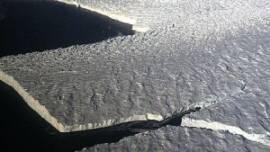 A mass of land ice that is sufficiently deep to cover most of the underly bedrock topography. An ice sheet flows outwards from a high central plateau with a small average surface slope. The margins slope steeply, and the ice is discharged trough fastflowing ice streams or outlet glaciers, in some cases into the sea or into ice shelves floating on the sea. There are only two large ice sheets in the modern world – on Greenland and Antarctica, the Antarctic ice sheet being divided into east and west by the Transantarctic Mountains; during glacial periods there where others.
A mass of land ice that is sufficiently deep to cover most of the underly bedrock topography. An ice sheet flows outwards from a high central plateau with a small average surface slope. The margins slope steeply, and the ice is discharged trough fastflowing ice streams or outlet glaciers, in some cases into the sea or into ice shelves floating on the sea. There are only two large ice sheets in the modern world – on Greenland and Antarctica, the Antarctic ice sheet being divided into east and west by the Transantarctic Mountains; during glacial periods there where others.
 Glaciar se define como una masa de hielo en la superficie terrestre, que fluye pendiente abajo (por deformación interna y por deslizamiento en la base), y restringida por la topografía del entorno (por ejemplo las laderas de un valle o las cumbres que lo rodean); la topografía del lecho es la mayor influencia en la dinámica y pendiente de la superficie de un glaciar. El glaciar se mantiene por la acumulación de nieve en las cotas altas, balanceada por la fusión a cotas bajas o por la descarga al mar (IPCC, 2001). Casquete de hielo es una masa en forma de domo y que cubre la zona alta de una región (menor que 50.000 km2 de area terrestre) que es considerablemente menor en extensión que las sábanas de hielo (IPCC, 2001).
Glaciar se define como una masa de hielo en la superficie terrestre, que fluye pendiente abajo (por deformación interna y por deslizamiento en la base), y restringida por la topografía del entorno (por ejemplo las laderas de un valle o las cumbres que lo rodean); la topografía del lecho es la mayor influencia en la dinámica y pendiente de la superficie de un glaciar. El glaciar se mantiene por la acumulación de nieve en las cotas altas, balanceada por la fusión a cotas bajas o por la descarga al mar (IPCC, 2001). Casquete de hielo es una masa en forma de domo y que cubre la zona alta de una región (menor que 50.000 km2 de area terrestre) que es considerablemente menor en extensión que las sábanas de hielo (IPCC, 2001).
 A floating ice sheet of considerable thickness attached to a coast (usually of great horizontal extent with a level or gently undulating surface); often a seaward extension of ice sheets. Nearly all ice shelves are in Antartic.
A floating ice sheet of considerable thickness attached to a coast (usually of great horizontal extent with a level or gently undulating surface); often a seaward extension of ice sheets. Nearly all ice shelves are in Antartic.







